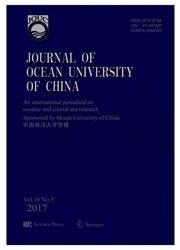

 中文摘要:
中文摘要:
We investigated the diversity and structure of free-living marine nematode communities at three sandy beaches representing typical intertidal environments of a temperate zone in Qingdao,Shandong Province,China.Average nematode abundance ranged from 1006 to 2170 ind.10 cm-2,and a total of 34 nematode genera were recorded,of which only 8 were common in all the studied beaches.Pielou’s evenness and Shannon-Wiener diversity index were the lowest at the second beach where nematode abundance was the highest.The highest species diversity index coincided with the lowest nematode abundance at Shilaoren beach.Sediment median grain size,sorting coefficient,and chlorophyll-a content were essential for differentiation in nematode abundance and species diversity,whereas taxonomic diversity of nematode was homogeneous across the three beaches.In 0–20 cm sediment profile,nematode abundance declined abruptly with depth,whereas nematode diversity changed gently with obvious difference in 16–20 cm layer.Sediment granulometry and chlorophyll-a content were the two foremost factors which influenced the vertical distribution pattern of nematode generic diversity.Non-selective deposit feeders constituted the most dominant trophic group,followed by epistratum feeders.Bathylaimus(family:Tripyloididae) dominated at the second and Yangkou beach,while Theristus(family:Xyalidae) prevailed at Shilaoren beach.Omnivores and predators became important at Shilaoren beach because of the high proportion of Enoplolaimus.Even though,nematode community of the studied beaches did not differ significantly from each other.
 英文摘要:
英文摘要:
We investigated the diversity and structure of free-living marine nematode communities at three sandy beaches representing typical intertidal environments of a temperate zone in Qingdao, Shandong Province, China. Average nematode abundance ranged from 1006 to 2170 ind. 10 cm-2, and a total of 34 nematode genera were recorded, of which only 8 were common in all the studied beaches. Pielou's evenness and Shannon-Wiener diversity index were the lowest at the second beach where nematode abundance was the highest. The highest species diversity index coincided with the lowest nematode abundance at Shilaoren beach. Sedi- ment median grain size, sorting coefficient, and chlorophyll-a content were essential for differentiation in nematode abundance and species diversity, whereas taxonomic diversity of nematode was homogeneous across the three beaches. In 0-20 cm sediment profile, nematode abundance declined abruptly with depth, whereas nematode diversity changed gently with obvious difference in 16-20cm layer. Sediment granulometry and chlorophyll-a content were the two foremost factors which influenced the vertical distribution pattern of nematode generic diversity. Non-selective deposit feeders constituted the most dominant trophic group, followed by epis- tratum feeders. Bathylaimus (family: Tripyloididae) dominated at the second and Yangkou beach, while Theristus (family: Xyalidae) prevailed at Shilaoren beach. Omnivores and predators became important at Shilaoren beach because of the high proportion of Enoplolaimus. Even though, nematode community of the studied beaches did not differ significantly from each other.
 同期刊论文项目
同期刊论文项目
 同项目期刊论文
同项目期刊论文
 期刊信息
期刊信息
